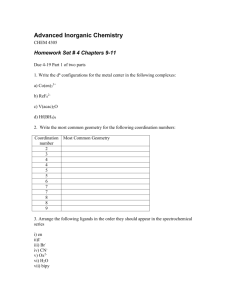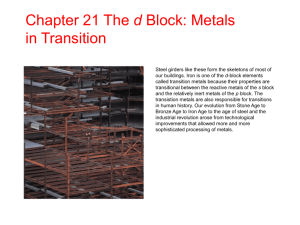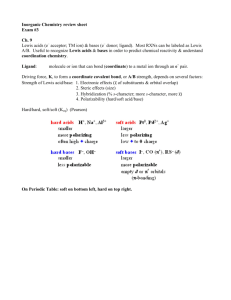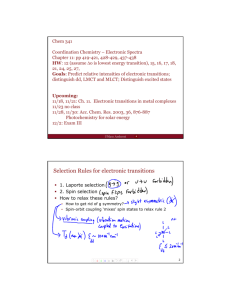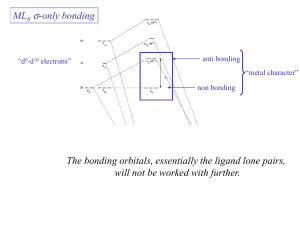Experiment 1 Powerpoint
advertisement
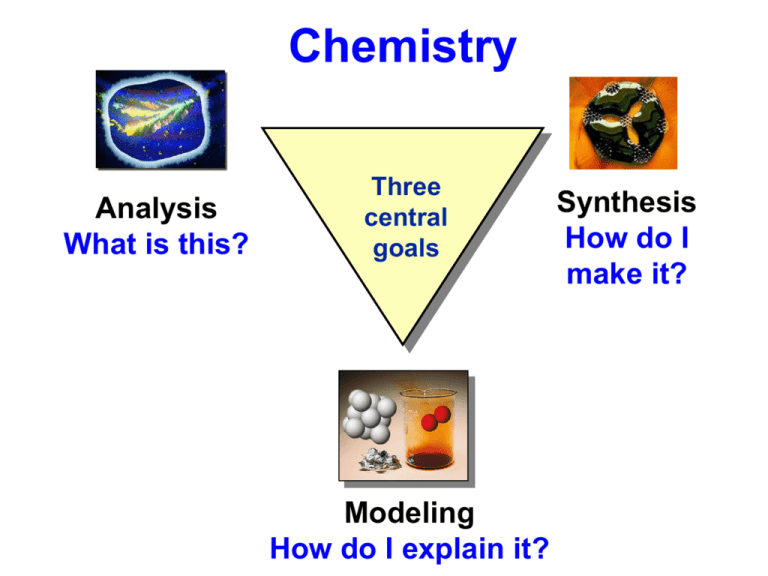
Chemistry Analysis What is this? Three central goals Modeling How do I explain it? Synthesis How do I make it? A Chemist’s View- How we think Macroscopic Three different perspectives Symbolic Microscopic or Particulate NaCl The Period 4 transition metals Colors of representative compounds of the Period 4 transition metals nickel(II) nitrate hexahydrate sodium chromate titanium oxide scandium oxide vanadyl sulfate dihydrate potassium ferricyanide manganese(II) chloride tetrahydrate cobalt(II) chloride hexahydrate Copyright © The McGraw-Hill Companies, Inc. Permission required for reproduction or display. zinc sulfate heptahydrate copper(II) sulfate pentahydrate Aqueous oxoanions of transition elements One of the most characteristic chemical properties of these elements is the occurrence of multiple oxidation states. Mn(II) Mn(VI) Mn(VII) Mn(VII) Cr(VI) V(V) Copyright © The McGraw-Hill Companies, Inc. Permission required for reproduction or display. Effects of the metal oxidation state and of ligand identity on color [V(H2O)6]3+ [V(H2O)6]2+ [Cr(NH3)6]3+ [Cr(NH3)5Cl ]2+ Copyright © The McGraw-Hill Companies, Inc. Permission required for reproduction or display. Linkage isomers An artist’s wheel Splitting of d-orbital energies by an octahedral field of ligands D is the splitting energy The effect of ligand on splitting energy The spectrochemical series •For a given ligand, the color depends on the oxidation state of the metal ion. •For a given metal ion, the color depends on the ligand. I- < Cl- < F- < OH- < H2O < SCN- < NH3 < en < NO2- < CN- < CO WEAKER FIELD SMALLER D LONGER STRONGER FIELD LARGER D SHORTER Copyright © The McGraw-Hill Companies, Inc. Permission required for reproduction or display. The color of [Ti(H2O)6]3+ Copyright © The McGraw-Hill Companies, Inc. Permission required for reproduction or display. High-spin and low-spin complex ions of Mn2+ Copyright © The McGraw-Hill Companies, Inc. Permission required for reproduction or display. Orbital occupancy for high- and low-spin complexes of d4 through d7 metal ions high spin: weak-field ligand low spin: strong-field ligand high spin: weak-field ligand low spin: strong-field ligand Copyright © The McGraw-Hill Companies, Inc. Permission required for reproduction or display. What is electronic spectroscopy? Absorption of radiation leading to electronic transitions within a molecule or complex Absorption Absorption [Ru(bpy)3]2+ 104 [Ni(H2O)6]2+ 10 200 400 UV 700 visible / nm (wavelength) ~14 000 25 000 visible 50 000 UV n / cm-1 (frequency) UV = higher energy transitions - between ligand orbitals visible = lower energy transitions - between d-orbitals of transition metals - between metal and ligand orbitals Absorption maxima in a visible spectrum have three important characteristics 1. number (how many there are) This depends on the electron configuration of the metal centre 2. position (what wavelength/energy) This depends on the ligand field splitting parameter, Doct or Dtet and on the degree of inter-electron repulsion 3. intensity This depends on the "allowedness" of the transitions which is described by two selection rules The energy of the absorption by [Ti(OH2)6]3+ is the ligand-field splitting, Do ES ES eg hn eg Do GS t2g complex in electronic Ground State (GS) [Ti(OH2)6]3+ GS t2g complex in electronic excited state (ES) d-d transition max = 510 nm Do is 243 kJ mol-1 20 300 cm-1 An electron changes orbital; the ion changes energy state The Jahn-Teller Distortion: Any non-linear molecule in a degenerate electronic state will undergo distortion to lower it's symmetry and lift the degeneracy Degenerate electronic ground state: T or E Non-degenerate ground state: A 2E g 2B 1g d3 d5 (high spin) d6 (low spin) d8 4A 2g 6A 1g 1A 1g 3A 2g A [Ti(H2O)6]3+, d1 2A 1g 2T 2g 10 000 20 000 30 000 n- / cm-1 Limitations of ligand field theory [Ni(OH2)6]2+ = d8 ion 2+ 3 absorption bands A eg Ni t2g 25 000 n / cm-1 15 000 LFT assumes there is no inter-electron repulsion Repulsion between electrons in d-orbitals has an effect on the energy of the whole ion d2 ion Electron-electron repulsion x2-y2 z2 eg z2 x2-y2 t2g xy xz yz eg t2g xy xz yz xy + z2 z xz + z2 z y y x x lobes overlap, large electron repulsion lobes far apart, small electron repulsion These two electron configurations do not have the same energy The Nephelauxetic Effect cloud expanding - some covalency in M-L bonds – M and L share electrons -effective size of metal orbitals increases -electron-electron repulsion decreases Nephelauxetic series of ligands F- < H2O < NH3 < en < [oxalate]2- < [NCS]- < Cl- < Br- < INephelauxetic series of metal ions Mn(II) < Ni(II) Co(II) < Mo(II) > Re (IV) < Fe(III) < Ir(III) < Co(III) < Mn(IV) Selection Rules Transition e complexes Spin forbidden Laporte forbidden 10-3 – 1 Many d5 Oh cxs [Mn(OH2)6]2+ 1 – 10 Many Oh cxs [Ni(OH2)6]2+ 10 – 100 Some square planar cxs [PdCl4]2- 100 – 1000 6-coordinate complexes of low symmetry, many square planar cxs particularly with organic ligands 102 – 103 Some MLCT bands in cxs with unsaturated ligands 102 – 104 Acentric complexes with ligands such as acac, or with P donor atoms 103 – 106 Many CT bands, transitions in organic species Spin allowed Laporte forbidden Spin allowed Laporte allowed
